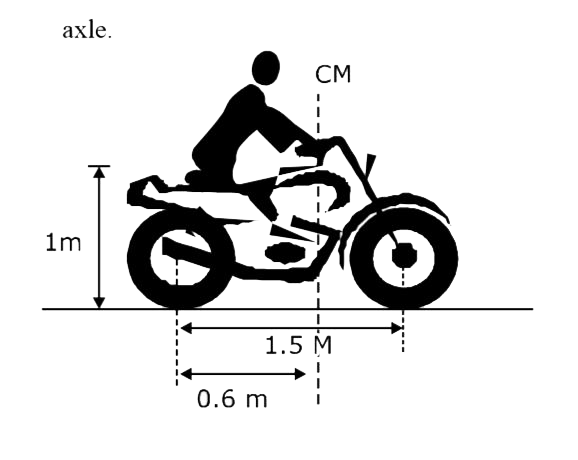A car weighs 1800kg. The distance between its front and back axles is 1.8m. Its centre of gravity is 1.05m behind the front axle. Determine the force (in newton) exerted by the level ground on each front wheel.
The correct Answer is:3675
Topper's Solved these Questions
- RAY OPTICS AND OPTICAL INSTRUMENTSBOOK - CENGAGE PHYSICSCHAPTER - RAY OPTICS AND OPTICAL INSTRUMENTSEXERCISE - QUESTION BANK
40 Videos
- SEMICONDUCTOR ELECTRONIC : MATERIALS, DEVICES AND SIMPLE CIRCUITSBOOK - CENGAGE PHYSICSCHAPTER - SEMICONDUCTOR ELECTRONIC : MATERIALS, DEVICES AND SIMPLE CIRCUITSEXERCISE - QUESTION BANK
12 Videos
Similar Questions
A car weighs 1800kg. The distance between its front and back axles is 1.8m. Its centre of gravity is 1.05m behind the front axle. Determine the force exerted by the level ground on each front wheel and each back wheel.
View SolutionA car weighs 1800kg. The distance between its front and back axles is 1.8m. Its centre of gravity is 1.05m behind the front axle. Determine the force exerted by the level ground on each front wheel and each back wheel.
View Solution
Knowledge Check
A car weighs 1800kg. The distance between its front and back axles is 1.8m. Its centre of gravity is 1.05m behind the front axle. Determine the force exerted by the level ground on each front wheel and each back wheel.
A4000 N on each front wheel, 5000 N on each back wheelB5000 N on each front wheel, 4000 N an each back wheelC4500 N on each wheel, 4500 N on each back wheelD3000 N on each front wheel, 6000 N on each back wheelA car weighs 1800 kg. The distance between its front and back axles is 1.8 m. Its centre of gravity is 1 m behind the front axle. The force exerted by the level ground on each front wheel and each back wheel is (Take g:10ms−1)
A4000 N on each front wheel, 5000 N on each back wheelB5000 N on each front wheel, 4000 N an each back wheelC4500N on each front wheel, 4500 N on each back wheelD3000 N on each front wheel, 6000 N on each back wheelThe tricycle weighing 20 kg has a small wheel symmmetrically placed 1m behind the two large wheels, which are also 1m apart. If the center of gravity of machine is at a horizontal distance of 25 cm behind the front wheels and the rider whose weight is 40 kg is 10 cm behind the front wheels. Then, the thrust on each front wheel is
A255 NB90 NC200 ND400 N
A car weighs 1800 kg. The distance between its front and back axles is 1·8 m. Its centre of gravity is 1·05 m behind the front axle. Determine the force exerted by the level ground on each front and back wheel
View SolutionThe distance between the inner and outer wheels of a car is 1.75 m and its centre of gravity is 0-50 m above the ground. What is the maximum speed with which the car can negotiate a curve of radius of 40 m without overturning ?
View SolutionThere is a man of mass 100 kg sitting on a motorbike of mass 150 kg. The distance of the axles of the wheels (wheelbase) is 1 . 5 m, the common mass center of the man and the motorbike is at a 1 m height above the ground level, and at a 0.6 m distance from the vertical line going through the rear axle.
What acceleration is needed to lift the front wheel?

View SolutionThere is a man of mass 100 kg sitting on a motorbike of mass 150 kg. The distance of the axles of the wheels (wheelbase) is 1 . 5 m, the common mass center of the man and the motorbike is at a 1 m height above the ground level, and at a 0.6 m distance from the vertical line going through the rear axle.
What acceleration is needed to lift the front wheel?

View SolutionThe centre of gravity of a car is at a height h and the distance between its wheel is 2a. The car moves on a level curve of radius r with speed v. Let N1andN2 be the normal reactions on the inner and outer wheels of the car. Then
View Solution
